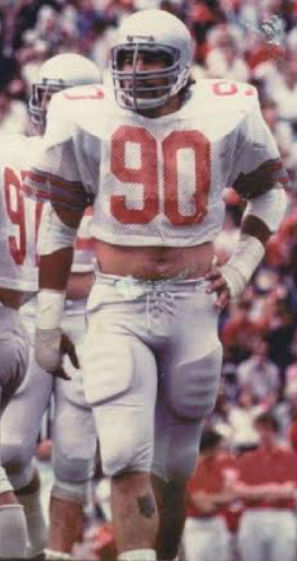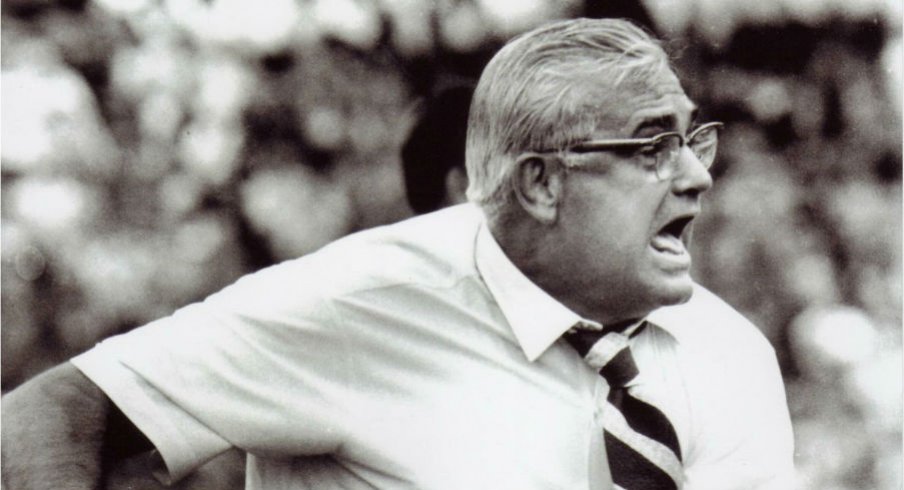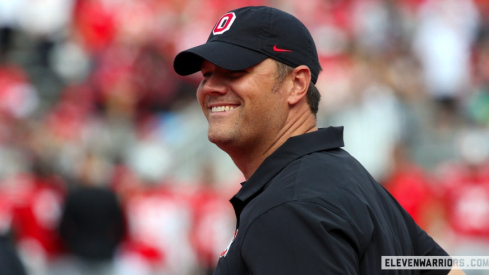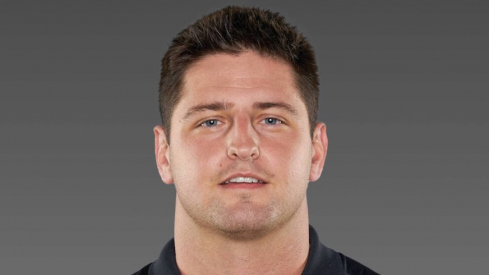On this day, back in 1913, Wayne Woodrow Hayes was born in Clifton, Ohio. He lived a couple of days shy of 74 years and one month before he left this Earth. For 32 of those years, Hayes served as a college football coach in the state of Ohio, including 28 at The Ohio State University.
Today would have been Woody’s 103rd birthday. The best way to celebrate is to look back at what life was like for his former players, nearly any one of which will remember the man fondly and with great reverence.
I spoke with Anthony Megaro earlier this week, a linebacker out of Chicago who played at Ohio State for Woody’s final two seasons and the first two years of Earle Bruce’s tenure. What I believed would be a 15-minute interview turned into an hour-long conversation — you can’t summarize Woody; he is a longform subject. Stories beget more stories when talking about the iconic coach.
As was often the case in his day, Megaro’s first contact with Hayes came during his recruiting visit. He accepted an invitation from defensive line coach Dave Adolph to visit campus and he was hosted by Tom Cousineau. After a Friday night reception, recruits toured the campus Saturday and learned about the school’s academics and saw some of the facilities. The rest of the visit has to be told in Megaro’s words.
“Saturday night is your actual first night with Woody,” he said. “It was at the restaurant called the Jai Alai. Woody was at a table with maybe the athletic director or something and all the players were having dinner at a separate table, adjacent to his, with your position coach. You’re talking and all of a sudden (then-defensive coordinator and linebackers coach) George Hill says “Woody wants to speak with you.” So now you get up and you look at the table and it’s just Woody. And you’re 18 years old and you’re basically shitting in your pants because now you’ve got to sit with this guy one-on-one.
“So I walk over to the table and I sit down and he looks at me. And the first thing he says to me was “Do you like peas?” I says “Yeah, I like peas.” He says “You have to try these.” And he lifts his plate up and he spoons some peas off onto a plate that was at the seat I was at. So I’m not stupid. I’m going to eat the peas. So I’m tasting the peas and I told him, “Yeah, they’re really good peas.” And then he looks me straight in the eyes and says “Do you want to come play football at Ohio State University?” And before I got anything out, he says “I’m offering you a scholarship. I want an answer right now.” And I just told him “Yes. I want to come play football at Ohio State University.” He stuck out his hand and shook and said “Welcome.””

It didn’t take Megaro and his classmates long to learn what kind of man Woody Hayes was.
“My brother had died in July before I was supposed to go to camp in August,” he said. “(Hayes) showed up with the coaching staff at my brother’s wake. No phone call or nothing. He just showed up. That’s the kind of guy he was.”
Megaro and the other incoming freshmen received a packet in the mail prior to reporting for camp with a letter from the coach outlining his expectations of all freshmen. Curiously, it also included a book called Word Power. During camp, Hayes demanded that players report to training table at 7:30 a.m. each morning, whether they were hungry or not. Freshmen and sophomores were required to go to study table. In addition, the freshman class had a mandatory class at 6:30 a.m. with Woody teaching vocabulary from Word Power three days a week.
Hayes had warned the incoming freshmen that they would be tested on the book.
“Nobody knew what he meant,” Megaro said. “We knew he wasn’t a teacher. There wasn’t school in August. But little did we know…he had class with us three times a week and he would teach out of this book. He had a chalkboard and everything. He would write the word. He made us get up and recite the word, give the meaning of the word, use it in a sentence, and then he would talk about things. I think the main thing (about the class) was that there’s more to life than football, especially afterwards, and if you don’t go to school, if you don’t study, if you don’t go to class, you’re going to end up being a bum. I think that’s the message he was trying to get across.”
Among Woody’s other frequent messages was to avoid drugs. Already in his 60s, Hayes was a bit, err, awkward when passing along warnings to his players.
“He goes “You’re going to run into these guys on the Oval sooner or later and they’re easy to spot. They’re standing there by themselves and they’re staring down at their shoes, wondering why their shoes are a certain color, or whatever.” He’d say “Stay away from those people because all they like to do is smoke pot.” And we would get the biggest kick out of that because that was one of the stories he’d tell constantly.”
Hayes was intense and he was consumed by a will to win. He loved his players and his overriding message to everyone he came into contact with was for them to pay it forward. Megaro took that message to heart and paid it forward by coaching youth football for 10 years after his OSU career was over, using what he’d learned from Hayes.
“I used everything,” he said. “The structure of the practice — everything that he ran at Ohio State, I ran — the way he made kids accountable. You had to have your grades or you couldn’t practice. I used all of that.”
Players didn’t get a lot of one-on-one time with Woody, who delegated many responsibilities to his position coaches. Megaro got more time than most early in his career by playing on the defensive scout team, because Hayes took responsibility for the offense. Under Woody, each player on the scout team got a bio of which opposing player they were portraying that week. They wore that player’s jersey number, learned about their tendencies, studied their film, and took what they learned out onto the practice field. This got Megaro into trouble with the head coach while he was portraying Iowa linebacker Tom Rusk.
I didn’t go to Ohio State just to play football. I went there to play for Woody. – Anthony Megaro
“One particular practice I kept blitzing and they didn’t pick it up and he was getting agitated,” said Megaro. “I remember I hit Ron Springs and I caught him in the backfield. Woody got all agitated and ran to the pile, grabbed me by the facemask, pulled my helmet and told me point blank “If you ever tackle my running back again, I’m going to kick you right in your ass.””
A mortified Megaro was consoled by upperclassmen, who assured him, “That’s the old man. That’s how he gets.”
Hayes had his quirks. He believed that he could minimize knee injuries in practice by watering the artificial turf of Ohio Stadium, where the Buckeyes practiced in those days. He would have the turf watered from the first practice through the final week of the season, making for some icy conditions in the Shoe when the temperatures dropped. He was known to take off his shirt and coach the entire practice to prove a point to players who wore towels under their helmets to fend off the cold. Woody wanted a tough team.
But he had a soft side, too.
“There was a running back from Kent, Ohio, named Harold Brown. He broke his neck his senior year. And when he broke his neck, everyone else stopped recruiting this kid. Woody went to the hospital and told that kid “Don’t worry, you’ve got a four-year scholarship to Ohio State,” knowing he would never play a down. That would sum up Woody in a nutshell. That’s the type of guy he was.”
Harold Brown went to Ohio State on an athletic scholarship. Bruce told him it was too dangerous for him to play football, so he ran track and tried out for the basketball team. That wouldn’t have been possible without the scholarship offer from Hayes.
Woody wasn’t much for pregame speeches. He knew his team was more talented than just about anyone Ohio State faced. He reinforced that by telling his players that they were better than the team they were playing and that they should win the game if they simply did what they’d been taught.
But there was a special team that Woody got up for — That Team Up North.
“I think that was part of his whole being for coaching was just to beat that team,” said Megaro. “If anybody ever tells you it was always him against Schembechler…it wasn’t. Woody loved Bo and Bo loved Woody. But, during that one week, it’s just pure hatred. We don’t even use that word (Michigan) there that week.
“We practiced, I would say, 10 to 15 minutes during the season, at the end of every practice, specifically geared toward that Michigan game. Everything was geared toward that game, even in summer practice he would put in stuff for Michigan and he let you know what you were practicing for, too. Like, if we were playing Northwestern, the three hitting days, the end of practice was always geared toward Michigan. You didn’t wait until Michigan week to practice for them.”
More on Hayes:
- He could spot his players out of uniform on campus and would always stop them and ask them if they needed anything and how school was going.
- He set his players up to succeed. If a player needed a tutor for any subject, they would get it. It was harder to fail under Hayes than to be successful.
- A stickler for the rules, Hayes once refused to sit down at Megaro’s kitchen table so that a home visit couldn’t be counted as “official.”
- Hayes notoriously avoided the subject of football altogether when visiting a player’s family. His focus was always on the university and what it could do for the young man’s future.
Megaro said he cried when he heard of Woody’s death in 1987. He still thinks about his former coach a lot and Woody is a main topic of conversation whenever the former linebacker spends any time around his former teammates. In Megaro’s basement, where he still works out, is a room full of items from his time at Ohio State. Most of the photos on the wall are from the two years he played under Hayes. Such is the impact that Woody had on his players.
“I didn’t go to Ohio State just to play football,” he said. “I went there to play for Woody. I think if you ask anybody, they won’t tell you “I went there because they always won and they always went to the Rose Bowl.” You played for Woody and the rest of the stuff just followed suit.”


